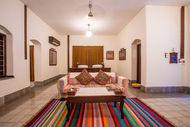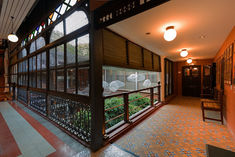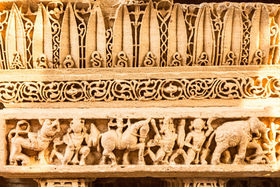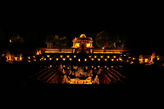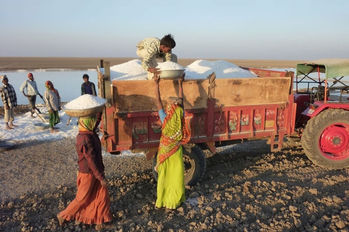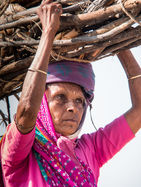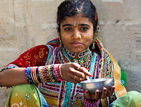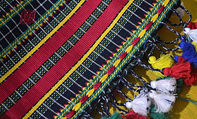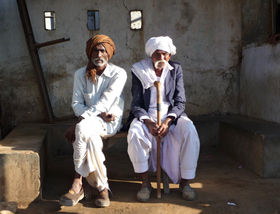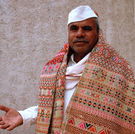Gujarat Textile Tour
Duration: 12 Days
Best Time to Travel: November to March
Highlights: Asiatic lions, blackbucks, migratory birds, salt desert landscapes, rare wild asses.
Itinerary Route: Ahmedabad → Velavadar → Gir National Park → Jamnagar → Greater Rann of Kutch → Little Rann of Kutch → Nalsarovar → Ahmedabad
DAY 01
Welcome to Ahmedabad: A City of Heritage and Textiles
Your journey begins as you land in Ahmedabad, a bustling city rich in culture and history
Our team is ready to assist you upon arrival, ensuring a smooth start to your adventure.
Rest of the day at leisure – Stay at The House of MG.
DAY 02
Threads of Legacy: Textiles, Gandhi, & Mata Ni Pachedi Art
Start this morning by visiting the local artisans who practice the sacred art of Mata ni Pachedi, often referred to as the ‘Kalamkari of Gujarat’.
This intricate hand-painted textile tradition is deeply rooted in the spiritual lives of the Vaghari community. Typically created as temple hangings, these cloth paintings depict the Mother Goddess in her powerful central form, surrounded by worshippers, deities, animals, and symbolic motifs. Using natural dyes and meticulous brushwork, the artisans bring ancient myths and devotional stories to life on fabric. This immersive experience offers a rare chance to witness a centuries-old craft and engage with the artists preserving this fading heritage.
Today, wooden blocks enable more detailed borders, but the heart of each piece is still created using the bamboo kalam, keeping this centuries-old spiritual art form alive. In a quiet corner of Ahmedabad, time stands still as artisans continue to create Mata ni Pachedi using methods passed down for over 750 years.
Each artwork begins with handwoven cotton, meticulously de-starched and treated with Harada paste to prepare it for natural dyes. The outlines—often fierce and divine figures—are first drawn in black, made from a traditional mix of jaggery and iron. Red, extracted from tamarind seeds, is then carefully filled in, while areas meant to stay white are intentionally left blank.
After each layer of colour is applied, the cloth is boiled in an alizarin solution to develop the hues. For the final wash, artisans still walk to the Sabarmati River. Only its flowing water, they believe, can carry away the excess dye without disturbing the purity of the image, just as it was done centuries ago.
Next, visit the historic Sabarmati Gandhi Ashram, a powerful symbol of India’s freedom movement.
Located on the tranquil banks of the Sabarmati Riverside, this was Mahatma Gandhi’s home and the heart of his non-violent resistance against British rule. His presence still resonates through the simple rooms and exhibits, offering a profound glimpse into his philosophy and life.
Originally founded in 1915 at Kochrab Bungalow, the ashram was moved in 1917 to this 36-acre site to support Gandhi’s vision for self-reliance, including farming and animal husbandry. Today, Sabarmati Ashram remains a living memorial to the spirit of Satyagraha and India’s path to independence.
This morning, visit the renowned Calico Museum of Textiles, with prior permission obtained. The museum remains closed on every Monday and public holidays.
Widely regarded as India’s premier textile museum, Calico houses an extraordinary collection of handcrafted fabrics representing five centuries of India’s textile heritage. The museum showcases rare weaves, intricate patterns, natural dyes, and traditional embellishments sourced from across the country. A must-visit for art lovers and cultural enthusiasts, it’s also a vital research center for scholars worldwide studying India’s rich textile traditions.
DAY 03
The Living City: Heritage Walk, Sacred Sites & Stepwells
Heritage Walks, Ancient Stepwells & Night Bites in Ahmedabad
Begin the day early at 7:30 AM with a guided heritage walk from the Swaminarayan Temple, weaving through Ahmedabad’s old city — past intricately carved wooden Havelis, the sacred Bhadrakali Temple, and the grand Jumma Mosque.
Pause for chai and snacks at GreenHouse Café, then head to the exquisite Sidi Saiyyed Mosque, home to the iconic Tree of Life jaali, a symbol of Ahmedabad’s timeless craft and architecture.
After lunch at a local restaurant, visit the Hutheesingh Jain Temple, an exquisite white marble temple dedicated to Lord Dharmanatha, the 15th Jain Tirthankara.
Next, marvel at the architectural brilliance of the Adalaj Stepwell, a five-storied, intricately carved Vav built in 1499. Stepwells like these were not only sources of water but also served as gathering places for the community.
Wrap the day with dinner or explore the buzzing Manek Chowk night food market, where jewellery by day turns into a street food heaven after 8 PM.
After lunch at a local restaurant, visit the Hutheesingh Jain Temple, an exquisite white marble temple dedicated to Lord Dharmanatha, the 15th Jain Tirthankara.
DAY 04
Weaves of Time: Patola, Rani Ki Vav & Modhera’s Sun Temple
After an early breakfast, journey north to Patan, home of the legendary Patola silk weavers. Visit master craftsmen who continue the rare art of double ikat, a tradition once reserved for royals, now preserved by the Salvi family.
Next, step into history at the 11th-century Rani Ki Vav, a UNESCO World Heritage site. This intricately carved stepwell, built by Queen Udayamati in memory of her king, is a breathtaking showcase of ancient Indian sculpture.
Later, explore the Sun Temple at Modhera — a 1,000-year-old architectural gem dedicated to Surya, the sun god. Its ornate pillars, stepped reservoir, and temple complex glow golden in the afternoon light.
By evening, arrive in the Little Rann of Kutch — India’s vast salt desert and home to unique wildlife. Check in at your eco-friendly resort, enjoy a warm dinner, and rest under the starry sky.
DAY 05
Wild Encounters & Craft Traditions in the Rann and Bhuj
Begin your day with a thrilling early morning safari in the Little Rann of Kutch, where you’ll spot the iconic Asiatic Wild Ass along with desert foxes and migratory birds in the surreal salt-crusted landscape.
After lunch, take a village safari to meet traditional communities like the Mir, Rabari, Bharwad, and Bajanias, each with distinct attire and customs— a vibrant window into Gujarat’s living heritage.
As you drive towards Bhuj, enjoy a photographic journey—spot nomadic Banjara caravans, windmills rising from the barren earth, and the gleaming salt pans of Kutch. Visit one en route to witness the ancient craft of salt harvesting.
Stop at Ajrakhpur village to explore the intricate world of Ajrakh block printing, a craft with roots in the Indus Valley Civilization, where natural dyes meet geometric precision on hand-carved wooden blocks.
Later, visit the LLDC Museum (Living & Learning Design Centre)—a stunning tribute to Kutch’s artisans, crafts, and creativity. The centre nurtures both the legacy and the future of traditional handwork. (LLDC Museum remains closed on every Monday & Public Holidays.)
Reach Bhuj by evening. Stay in a comfortable hotel or at a charming 4-room Parsi heritage homestay. Unwind and reflect on a day rich in colour, culture, and craft.
DAY 06
Looms & Legends: Bhujodi Weavers and Ahir Embroiderers
After breakfast, head to Bhujodi, a village where every thread tells a tale. Meet master weavers like Chamanlal Siju, an 11th-generation artisan and National Awardee, whose family has been weaving magic on handlooms for centuries. Here, the rhythm of the loom mirrors the harmony between Rabari herders and Vankar weavers, united by tradition and survival.
Continue to Dhaneti village, where you’ll meet the Ahir women artisans, known for their distinctive embroidery using round mirrors, floral, and geometric motifs. Every stitch here reflects time, patience, and pride.
Return to Bhuj for a late lunch, then enjoy a rare opportunity to meet Mr. Wazir, a textile connoisseur with an extraordinary private collection of vintage Indian and Kutchi textiles. His storytelling and textile knowledge are as rich as the fabrics he curates — and yes, select pieces will be available for purchase.
In the evening, stroll through the local market in Bhuj, soaking in its colours, crafts, and character. Dinner and overnight at your hotel or a charming Parsi heritage homestay.
DAY 07
Art in Every Thread: Rogan Painting, Copper Bells & Lacquer Craft
After breakfast, drive to the artistic village of Nirona, a hidden gem in Kutch known for preserving three rare crafts, each passed down through generations.
First, step into the magical world of Rogan Art, practiced exclusively by the Khatri family for over 300 years. Watch a live demo where castor oil is turned into vibrant paint, then spun by hand into intricate designs using a metal stylus.
Fun fact: one Rogan painting even made it to the White House!
Next, meet the Luhars of Nirona, the creators of Copper Bell Art. These musical bells, with roots in Sindh, are made without welding and tuned entirely by ear. Artisan Ali Saddiq will greet you with a warm smile and a quick demonstration of how a simple metal transforms into a melodious work of art.
Then, discover the rhythmic hues of Lacquer Work, brought to the region by Wada artisans, descendants of semi-nomadic tribes. Watch how wooden toys, spoons, and rolling pins come alive with vibrant spirals using lacquer made from the Rhus tree sap.
If you're lucky, the courtyard might echo with the soul-stirring voice of a Meghwal folk singer, home between global tours.
By evening, drive to Hodka Village and check in at a warm, community-run eco-resort. Dinner and overnight stay under the starlit sky of Kutch.
DAY 08
Tribal Spirit & Timeless Views: Villages, Pottery & The White Rann
After breakfast, immerse yourself in the rich tribal heritage of Kutch by visiting the Jat and Pathan communities. Known for their distinct embroidery, bold jewelry, and strong pastoral traditions, these communities offer a fascinating glimpse into the nomadic roots and cultural identity of the region.
Post-lunch, drive to Karo Dungar (Black Hill) — the highest point in Kutch. From here, take in the sweeping view of the Great Rann of Kutch, where the endless salt desert stretches to the horizon. A sight so surreal, it feels like standing on the edge of another planet.
Continue to Khavda Village, where local potters shape earth into art using age-old techniques. Watch their hands mould the clay with instinctive precision, decorating each piece with rustic charm.
As the sun dips low, head to Dhordo for a magical evening in the White Rann. The vast salt flats glow under the fading light, turning golden, silver, and then moonlit white — a landscape unlike any other.
Return to Hodka for dinner and an overnight stay at your community-driven eco-resort. Let the silence of the salt desert lull you to sleep.
DAY 09
Coastal Charm: Mandvi’s Royalty, Dhow Yards & Beachside Bliss
After breakfast, leave the salt deserts behind and drive to Mandvi, a coastal town known for its tie-and-dye textiles and tranquil beaches. Check in to your luxury beach resort, where the Arabian Sea greets you with golden sands and ocean breezes.
Later, visit the Dhow-building yard, where skilled craftsmen hand-build wooden ships, just as their ancestors did centuries ago for trading across the Arabian Sea. Don’t forget to stop by the Sagar Ship Model Shop for intricate, handmade replicas of these majestic vessels — perfect keepsakes from coastal Kutch.
Post-lunch, step into regal elegance at the Vijay Vilas Palace, the summer retreat of the royal family of Kutch. Its grand architecture, stained glass windows, and sea-facing balconies have even graced Bollywood films.
As the sun sets, relax by the sea at your resort, lulled by the rhythm of waves. Overnight at Mandvi.
DAY 10
Farewell Kutch: Journey Back with Desert Memories
After a memorable journey through Gujarat’s wilds and crafts, it's time to head home. After breakfast, drive to Bhuj or Kandla to catch your afternoon flight to Mumbai, or choose to drive to Ahmedabad if your international flight departs late at night or early next morning.
As you leave behind salt flats, ancient stepwells, and artisan villages, you carry with you the threads of heritage, landscapes, and stories that make Gujarat truly unforgettable.
.png)







